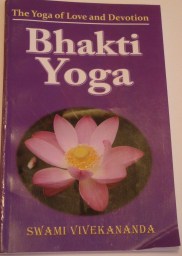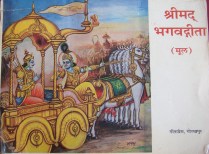This is the fourth and the last post of the series “Four Spiritual Practices and Four Yogas.”

“Congratulations to 2014 Graduates”
The high school graduates are already in colleges and the college graduates are either working or in graduate colleges. I am sure these spiritual practices will help them and all of the readers.
In the first part, I shared my thoughts on Jnana Yoga and Karma Yoga, in the second part on Raja Yoga, and in the third part on Bhakti Yoga.
In this post, I am going to share my thoughts on the four spiritual practices, which are considered the practices of the four yogas. These four practices are not mutually exclusive, meaning they do have a few things in common and are interconnected. For example, it is very difficult to be a Jnana Yogi without devotion, self-control and unselfish service. Similarly for all of the other three yogas, one cannot be exclusively one kind of a yogi. Swami Vivekananda wanted his disciples to practice all four yogas to speed up their spiritual paths. Practicing all four yogas is like driving a car with four cylinders instead of one cylinder, or flying an airplane with four engines and not only one.
The First Spiritual Practice (Jnana Yoga):

The first spiritual practice consists of Reading, Reflections, and Meditation.
(The numbering first, second, etc. is just for listing purposes. They do not signify the order of the practices. Any of the four practices could be the first practice.)
(i) Read and Reflect:
We have to read the scriptures and the lives and teachings of realized souls, and reflect upon them for the following purposes:
– to realize that the goal of human life is God realization, which is the highest state of knowledge that a human being can attain.
– to realize that this highest state of knowledge provides everything that a human being is seeking: peace of mind, unlimited bliss, a deeper understanding of life, and fulfilment.
– to learn that even though we have to live in this world and perform our duties, the goal of life is NOT making money, producing children, and running around to do errands to acquire little pleasures.
– to realize that no worldly pleasure or object can give us unlimited happiness in life. Worldly objects and sense-pleasures are limited and can give us only limited happiness and in return, we pay a very high price and suffer bitter consequences.
-to find out the way to realize God.
– to understand the characteristics of a person who had realized God.
– to learn how saints and sages have struggled hard to realize God.
– to enjoy reading about God and His/Her devotees.
– to realize that there is one life, one consciousness, and one God whom Vedanta refers to as Brahman. The same Brahman resides in each one of us as a soul called the Atman. It is divine. Its nature is Sat-Chit-Ananda (Existence-Knowledge-Bliss absolute). That is our true identity and to realize It is our goal.
– to intensify our desire to realize the Atman lying within us.
If we read the scriptures and the lives and teachings of saints and sages but cannot fulfill the above purposes, then our reading and reflections become only an intellectual exercise. There is very little gain.
When we read teachings of saints and sages, we have to remember that everything we read may not be applicable to us at that time or, in some cases, may not be applicable at a later time either. There are some universal teachings that are applicable to everyone all the time. But, there are also teachings that were given to specific devotees and are only applicable to similar minded devotees in similar situations. Sri Ramakrishna taught things according to the needs of the devotees. Some may look contradictory. For instance, one of Sri Ramakrishna’s devotees lacked courage and did not stand up for the right cause. Sri Ramakrishna told him to be courageous, to be bold and stand up for what he believed to be true. However, when another devotee, who was aggressive in nature, came to Thakur in the exact same situation, Sri Ramakrishna asked him to be humble.
(ii) Meditation:
Along with reading and reflections, we have to meditate on Brahman which is permanent. The nature of Brahman is “Sat-Chit-Ananda” – Existence-Knowledge-Bliss Absolute.
How do we meditate on the Existence Absolute part of Brahman? We should realize that the whole universe came from Brahman. The universe resides in Brahman and is nourished by Brahman. Ultimately, the whole universe will dissolve in Brahman. Brahman is the Ultimate Reality. Everything else is constantly changing and exists only for a short time, even though this short time could be millions of years. We meditate and realize that Brahman has become everything. A potter makes various utensils from clay. Everything was, is, and will be clay. A goldsmith makes various kinds of ornaments like necklaces, rings, earrings, bracelets from gold. They all look different, but ultimately it is all gold. Similarly, we meditate and realize that Brahman has become all people and all things around us. We then desire nothing to possess and hate nothing.
Also, through meditation, we realize that the same Brahman is residing in us as the Soul or the Atman. A pot filled with ocean water is floating in an ocean. The water inside the pot is the same water lying outside the pot. All the qualities of the ocean water exist in the water of the pot. Similarly, Atman has all the qualities of Brahman. Meditate on the idea that an individual is like a pot filled with ocean water freely floating in an infinite ocean. When the pot breaks the water inside merges with the water outside. The pot is our ego, which separates us from the infinite Brahman. This is how we meditate on the Existence Absolute part of Brahman.
We meditate on the Knowledge Absolute part of Brahman. Through meditation, we realize that Brahman had created all the brains of the world, is creating more brains now and will create them in future. The Ultimate Brain is Brahman. Each brain has partial knowledge and is a part of that Ultimate Brain.
We meditate on the Bliss Absolute part of Brahman, and realize that all of the happiness in the world is either a direct, or reflected, or deformed bliss of Brahman. Satvik happiness, derived from purifying the mind, doing prayers, meditating, and doing unselfish service to society, is a direct experience of the Bliss of Brahman. Rajasik happiness, which comes from fulfilling pleasures of the body and mind, is a reflected Bliss of Brahman. And tamasik happiness, which comes from ignorance and harming people, is a deformed Bliss of Brahman. Rajasik and Tamasik happiness bring more miseries and bondages with them, while Sattvik happiness frees us from miseries and bondages.
All of the happiness of the world combined together is just a small fraction of the Bliss of Brahman. The Bliss of Brahman which has been realized by many does not depend on any person or any object of the world. When we realize our true identity, which is our divinity or Atman, then we experience this Bliss of Brahman. Then and only then do all the miseries of life vanish.
There are various ways to meditate as a part of the Jnana Yoga practice. We can think that
– an individual self is like a bird flying freely in an infinite sky of consciousness
– an individual soul is a fish swimming freely in an infinite ocean of consciousness
– an individual soul is a point of light in an infinite luminous surrounding that envelops everything
– an individual self is a pot filled with ocean water and is surrounded on all sides by the ocean water (Consciousness of Brahman)
– in the heart there is a lotus, and in the middle of this lotus is an un-flickering steady lamp. The lamp represents the Self-awareness and un-flickering of the lamp represents our steady mind being merged with Brahman.
– a light spot in our heart (representing the Atman) slowly increases and merges into an infinite, all-pervading illumined space
– the whole universe is covered with divine consciousness or Brahman just as everything around us is covered with water during the monsoon
The bird and the sky, the fish and the ocean, the pot and the ocean, the light spot and the illumined environment are all supports for the beginner to focus the mind. Then they become steps to realize that everything is Brahman including oneself.
The Second Spiritual Practice (Bhakti Yoga):

For Bhakti Yoga, there are three major practices: Prayer, Japa, and Holy Company.
(1) Prayer:
One must do prayer at least twice a day – once in the morning and once in the evening. We should be aware that prayer is more than physical food. A sincere seeker of God should not miss any day without prayer. In the initial stage of spiritual development, one should not miss prayer for any day and one should make all efforts to keep a fixed prayer time. Later on, when love for prayer and God increases, one will naturally follow the regularity of time and prayer. At that time, if one is helplessly engaged in some other activity, one’s mind will start praying even if one physically misses the regular prayer.
The length of the time for prayer is not important. The important thing is to be sincere in our prayer. We have to focus our mind on the prayer and its meaning, and feel the presence of God. If our prayer is sincere, then God comes and enjoys our prayer. Suppose in a prayer we may say, “O God! You are my mother and father. You are my sibling and a friend. You are my knowledge and wealth. You are everything for me.” If we say this, we should feel that God truly is our mother, father, friend and everything. If we only do this one prayer sincerely, feel its meaning, think about it, and practice it in our lives, then no other prayer is necessary. As a result of this one prayer, all of our worldly demands, desires, miseries, fear and weaknesses will go away. Through this one prayer we can have God-realization.
Initially, the mind may wander around, so a variety of prayers is necessary. But we hope that our mind becomes focused in some part of prayer. As we progress, our mind remains in prayer and one thought of the prayer can lift the mind to God and enjoy His/Her presence. Prayer is necessary to develop love for God. Sri Ramakrishna says that when love of God develops, then by listening to God’s name, one has “romanch” (goose-bumps), tears of joy flow naturally from the eyes, and one does not like anything else except name of God. At that time, one’s life becomes transformed for good. All of the virtues described in the Bhagavad Gita shlokas 12.13 -12.19 manifest in the devotee. These virtues include loving all, hating none, having humility, being truthful, lacking jealousy, and balancing the mind in all circumstances among others.
To do regular prayer at home, one needs a prayer room or a quiet prayer corner. That place must be used solely for prayer. It has to be clean and may have an altar with pictures of the forms of God that one likes. One can decorate it with flowers, clothes, and other items. Try to keep the decoration simple. Too much decoration may distract the mind; simple yet artistic decoration may create a pleasant environment. Lighting a lamp and burning incense create a mood for prayer.
Prayer may include worship, arati, hymns, bhajans, dhoons, doing japa, and reading inspiring biographies and teachings of Holy People who have realized God. If people cannot sing, then they can listen to arati, hymns, bhajans, and dhoons from audio CDs. Prayer can be a silent prayer done in one’s mind. The idea is to forget everything about the world, including one’s body and focusing the mind on God. If a prayer is done sincerely, many inspiring thoughts may come on the surface of the mind, doubts may be destroyed, the mind becomes serene and peaceful, faith in God and one’s own divinity becomes stronger, the restlessness of the mind starts going away, and one develop inner strength to face any problem in life.
(2) Japa:
Prayer should lead a devotee into the important spiritual practice of Japa. Japa is the repetition of God’s name with love. The name of God comes in the form of a Mantra. These mantras have been evolved over thousands of years and, by repeating them, many have had God-realization. That is why these mantras are potent. Repeating them properly with a true love of God will produce great spiritual results. If one can get a mantra from a God-person who has realized God or has been much advanced in spiritual life, then the mantra has a special power. If one has not found such a person, then one can select a mantra of the form of God one likes and repeat it with sincerity and love. God will be happy with this repetition too.
In japa, we can think that God is happily and lovingly sitting in front of us just as our loving father, mother, grandparent, or any spiritual teacher is sitting in front of us. One can then meditate on God’s feet, hands, chest, ears, eyes, mouth, and whole face while repeating the mantra. Then, meditate on the lotus feet of the form of God. One can also think of the life incidents and teachings of the form of God to whom one is praying. Sometimes it is helpful to read life incidents and teachings of the form of God before doing japa. For example, one can read from the Ramayana before doing japa of Lord Rama; one can read a portion of the Bhagavatam before doing japa of Lord Krishna; one can read the Shiva Purana or the meaning of the Shiva mahimna hymn before doing japa of Lord Shiva; one can read The Gospel of Sri Ramakrishna before doing japa of Sri Ramakrishna.

Singing dhoons, bhajans, or hymns also help in focusing our mind in japa. Japa leads one to meditation. While doing japa, when no other thought except the thought of God remains in the mind, then meditation begins.
Sri Krishna says in Bhagavad Gita, “O Partha! I (God) am easily revealed to the person who is constantly engaged in spiritual practices and is thinking of me with focused mind.”
(3) Holy Company: Sri Ramakrishna said that Bhagavat, Bhakta, and Bhagavan are the same, meaning that the scriptures of God, the company of a devotee of God and being with God are all the same. To develop love for God, holy company is most important. We need a living example. We need to see and be with a person who truly loves God. In the world we find people everywhere who love money, name-fame, shopping, food, comforts, and worldly pleasures. It is rare to find someone who truly loves God and finds that all other worldly are pleasures less important. Many saints have praised the importance of having holy company. Sometimes a simple action, expression, or hint coming from a holy person may transform our lives completely for good. Through this, our doubts can be destroyed and our faith in God becomes stronger.
But how do we know if our company is holy? A company is holy if in their presence our holy thoughts come to the surface of our mind. Through sincere prayer, we can prepare our mind to understand the spiritual impact of holy company. Many times people go to God-people and discuss politics or trifle worldly things that they themselves cherish. But, this is not the purpose of holy company. Out of love and a desire not to hurt others, holy people may talk a little bit about these things, but they really cherish talks about God and spiritual development more than anything else.
Swami Adiswaranandaji used to say that people make counterfeits because money is valuable, and mimic gold because it is precious. No one mimics dirt because it is not precious. Similarly, since holy company is the most valuable thing in the world, a few people may try to mimic holy people. As people have to be careful about counterfeits, people have to also be alert about holy company. But once we find true holy company, we should think that we are blessed by God. We have to take advantage of such holy company to develop spiritually. The Shrimad Bhagavad Gita says that we have to respectfully approach God-people and ask our questions to remove our doubts, to develop love for God, to understand the true nature of God, and to find and remove obstacles of our spiritual path.
The Third Spiritual Practice (Raja Yoga):

The two main spiritual practices of Raja Yoga are self-control and the focusing of the mind.
(1) Self-control by practicing values:
Most people think Yoga means physical exercises. However, this is an extremely simplified meaning. Yoga exercises are good in that they keep our bodies in good shape. Yet, the only purpose of maintaining our bodies is to prevent them from being an obstacle in realizing our inner divinity – God residing in us.
This is the same purpose for the breathing exercises (Pranayam) of Yoga. Breathing exercises help the mind to be ready to focus on our inner divinity or Atman. However, Swami Vivekananda warns us, saying that these breathing exercises have to be done in the direct guidance of an expert and in a measured way. If the exercises are wrongfully done, then they may damage our brains. Shri Shankaracharya says that if we do not realize our inner divinity or Atman through the breathing exercises (Pranayam), then we are torturing our nose.
The real self-control comes by practicing values including yama (practice of non-violence, truthfulness, not to steal, practicing celibacy, and simple living) and niyama (practicing purity, contentment, austerity, study of scriptures, and worship of God) of Raja Yoga. Let us keep it clear in our mind that sincerely practicing values to get control on our senses and mind is real Raja Yoga. In his Raja Yoga book, Swami Vivekananda describes the following values to become a yogi:
“He who hates none, who is the friend of all, who is merciful to all, who has nothing of his own, who is free from egotism, who is even-minded in pain and pleasure, who is forbearing, who is always satisfied, who is ever devoted to yoga, whose self has become controlled, whose will is firm, whose mind and intellect are given unto Me-such a one is My beloved bhakta.
He from whom comes no disturbance, who cannot be disturbed by others, who is free from joy, fear and anxiety-such a one is My beloved.
He who does not depend on anything, who is pure and active, who does not care whether good comes or evil, and never becomes miserable, who has given up all efforts for himself, who is the same in praise or in blame, silent and thoughtful, pleased with what little comes his way, homeless, having the whole world for his home, and steady in his mind-such a one is My beloved bhakta.” (Translation of Bhagavad Gita, Chapter 12, shlokas 13 –19)
When we see so many values to practice, we become disheartened. But, in the same chapter, Swami Vivekananda says, “Be not afraid if you are not perfect in all of these (values). Work and you will succeed.” If we truly practice any one of the values described above, then all of the other values will come to us.
(ii) Focusing our mind (Meditation):
The purpose of all the efforts of Raja Yoga practices (including the practicing of values) is to attain control over our self and become fit to focus our mind to attain the highest knowledge – to realize our inner divinity and be free from all bondages.
Every day, we have to sit and try to meditate on our true identity. Our true identity is Atman, which is eternal. By discriminating between what is permanent and what is not permanent, we can focus on our Atman. For example, our body and the mind constantly change. Because of the unchangeable Atman in the background, we perceive these changes of the body and mind. We should try to focus our mind on the unchangeable Atman. We have to try to go beyond our sense of “I”, which is limited to our name and form, our gender, our age, our achievements, our belongings, our desires and attachments, our limitations, our birth, and death. Our true identity, the Atman, is beyond these limited things. It is eternal, infinite, formless, Existence-Knowledge-Bliss Absolute. If we try to focus on this Atman every day, by denying all the false identities, then with other supportive activities we will be able to make progress and we will start feeling our true identity. What is the test of our progress? All of the characteristics or values described in the above-mentioned Bhagavad Gita shlokas will start manifesting in our lives and we will feel blessed. Then, we will find the true meaning of life and life truly becomes worth living.
Focusing our mind is not an easy task. Arjun, the hero of Mahabharat who could focus his mind in archery on an eye of a bird sitting on a tree, told Sri Krishna in Bhagavad Gita that to focus the restless mind in meditation is as extremely difficult as controlling the powerful wind. Sri Krishna agreed to Arjun and said, “O Mighty Arjun, yes, the mind is restless and very difficult to control. But, through constant practice and detachment, it can be controlled. This Yoga (realizing Brahman) is extremely difficult for one who has no self-control. But, this Yoga can be attained through proper spiritual practices by one who has self-control.” (Gita 6.33 – 6.36)
The Fourth Spiritual Practice (Karma Yoga):

The practice of Karma Yoga is unselfish service.
Who can do unselfish service?
We all have to perform our responsibilities and we are happy when we can do something for others. All of this constitutes service. Karma Yoga teaches us how we can make this service a spiritual practice.
Many people like to give lectures and/or guide others without building up their own lives. Similarly many people want to do service without first becoming fit to do service. Only a person who is “unselfish” or sincerely “trying to be unselfish” can do an unselfish service. “Trying to be unselfish” means to be committed to realizing one’s true identity as the divine Atman. He/she sees the same divinity in all beings and all things in the universe. Until one realizes this identity or ‘sameness’ in everything, one cannot be truly unselfish. If we are selfish, we might do harm to people whom we are serving. For example, if I am attached to my children, then I might be ignoring their weaknesses. I may not be able to tell them what is right and what is wrong. And in the name of doing service, I might be indirectly nourishing their harmful activities.
While doing service, somehow desire for name-fame, recognition, worldly-gain of any form creep in, and the service deteriorates into an ugly form of selfish worldly activity. If one does any work with a selfish motive, then it is okay, but doing selfish worldly activity in the form of service is ugly and counter-productive. A sincere Karma Yogi has to constantly watch him or her to avoid seeking any selfish motive from his/her service.
How can one be unselfish?
Practically, in order to be unselfish, one has to be selfish for one’s own spiritual development. We have to realize that in an absolute sense, we cannot do anything good in the world. The world is perfect as it is. Many people have tried to make this world a perfect place, and we see that the world has not become perfect and the fundamental problems remain same. Only the formats of the problems change. The problems created by jealousy, hatred, greed, and other vices continue to appear in different forms. Should we not try to do good then? Yes, we must try to do good for others in whatever way we can. But we have to remember that by trying to do good in the world we are doing good to ourselves. A true Karma Yogi is thankful to God for receiving an opportunity to do something good for others and in this process is able to expand himself/herself from his/her little self. If we have the spiritual goal to realize our true identity, which is the Self or Atman, then we can think of this doing good as a spiritual practice to go towards our Atman. We will then measure the success of our service not by the changes we have made in the world, but in terms of how much progress we have made in realizing this true identity and ‘oneness’ (seeing the same Atman in all). This way, even if the people whom we have served turn against us and blame us, we will not be disturbed. We will be able to remain calm and continue to serve. Also, if the people whom we have served praise us and shower us with worldly things, we will not be flattered or become tempted, but remain calm, controlled, and continue to serve without any selfish motive.
What makes us selfish?
We know that worldly attractions, prosperity, desire for name and fame, recognition, body-mind pleasures etc. make us selfish. Yet if we go deeper, we find that “me and mine-ness” and “doer-ship” also make us selfish. All worldly temptations come from these things. When we separate ourselves from Brahman, the Ultimate Reality, with the “little ‘I’”, covered with the body and mind, then the “me and mine-ness” and the “doer-ship” begin.
How do we get rid of the “me and mine-ness” and the “doer-ship”?
In order to get rid of these two, we have to start looking at ourselves and the world in their Reality. We have to recognize that some power or God has created this world, that It is nourishing this world, and that It will dissolve this world. We have very little control on ourselves and on the world. In fact, we have no total control on our own bodies. This limited control may even be a good thing because, with total control, we may harm ourselves. We have to remember that the world was going on before our birth and will go on after we die. Compared to the whole infinite universe, we are just tiny little things. Yes, as the Atman—a part of Brahman—we are infinite and have infinite power as Brahman. But, as our limited selves with just our bodies and minds, we are finite and have very little power. By realizing that we are the instrument in the hands of Brahman, the Ultimate Reality or Power, we can lose our “me and mine-mess” and “doer-ship.” Sri Ramakrishna says to take care of all of our responsibilities as caretakers, appointees of God, or as instruments of God. He gave the example of a baby-sitter who raises children of his/her master as his/her own but knows very well that they do not belong to him/her. Another practice in ridding ourselves of selfishness is to offer the results of our services to God.
Conclusion:
In brief, it is good to keep in mind the following four spiritual practices in order to attain the Ultimate Spiritual Goal:
(1) Daily prayer, japa and meditation
(2) Reading from inspiring books and keeping holy company
(3) Practicing values and
(4) Doing unselfish service.
I sincerely wish all the best to all who are striving for spiritual development. May God help us all.
(My special thanks to Ronak and Nisha Parikh for their help in editing this post.)















